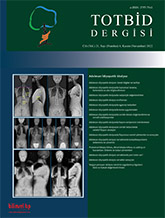
The classification systems defined for diseases are necessary for health professionals who are faced with the disease to speak the common language. This effort has been tried to be put forward in the diagnosis and treatment of adolescent idiopathic scoliosis (AIS) in different clinics and especially in the operation of patients in advanced stages by spinal surgeons and determining their fusion levels. Long years after the definition of the classification system that was first presented by Ponseti and Friedman in 1953, the King-Moe classification system started to be preferred in AIS surgeries. Problems which were experienced due to the fact that this system did not take into account the sagittal plane deformities, were tried to be overcome with the classification system provided by Lawrence G. Lenke in 2001. The effort for speaking common language to clearly determine the fusion levels was supported by Qiu et al. in 2005 with a more detailed classification and a system for three-dimensional evaluation of the deformity. In our article, it is aimed to review the AIS classification systems that have been studied so far.